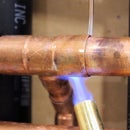Introduction: The 10 Tools You'll Need As an Apprentice Plumber
Welcome back guys, so as you may know, I am a journeyman plumber and today I wanna show you my TOP 10 favorite everyday carry tools.
Step 1: THE ADJUSTABLE PLIERS
So starting with number one, the adjustable pliers. Your adjustable pliers are a stable for your EDC, you’ll be using them for many things such as screwing nuts, tightening small pipes and many other uses. You’ll want to get a dependable brand such as Channel Lock and Knipex or “K”nipex as some may call them, as they will be going thru a lot of hard labor, so keep that in mind.
Step 2: THE ADJUSTABLE WRENCH
Next up, the adjustable wrench. You’ll wanna have an adjustable wrench for a few reasons. First, it has a smooth jaw, unlike the adjustable pliers which are meant to grip on things, these are meant for either finishing work or just an everyday wrench. And secondly, some models have a hole at the end for hanging them but I use it to make offsets in threaded rod when something is in the way.
Step 3: THE TAPE MEASURE
Number 3 is a tape measure. There are plenty of tape measures out there, but my most trusted brand is Stanley. Stanley tape measures, Fat Maxes to be more precise have been great to me in the past years and I can’t complain, they are durable under all conditions and the price is very competitive, but this is my opinion and you should experiment on your own to see what suits you best. If you aren’t in the states, I suggest getting an imperial and metric tape measure, as often, your plumber will give you metric measurements, so I strongly suggest it.
Step 4: THE TORPEDO LEVEL
Number 4 is a torpedo level. If you want things to be straight, you’ll need a level on your person at all times. Sometimes you’ll need to install a vertical water line and other times a drain which requires a slope, in both of these cases, you’re gonna need a torpedo level and my personal choice for torpedo levels are ones with strong magnets, easy to read vials and a solid body construction. I don’t suggest getting the crème de la crème of all levels as they’re more prone to getting stolen but rather one that is more affordable such as a fatmax or Milwaukee.
Step 5: BOX CUTTER/UTILITY KNIFE
Next up is a box cutter or utility knife. I always keep mine in a leather pouch I have on my right side so it’s easily accessible for when I receive an order or whatnot. There are many different types and sizes of box cutter such as these but my go-to knife and everyday carry is this one. Olfa makes great, solid knives and the blades are very sharp and for those who don’t know why the blades are ridged like they are, here’s why. When you snap a segment off, you get a new cutting edge which is a very neat feature and a lot of people don’t know of.
Step 6: A MARKER
Number 6 is a marker. I’ve tried all kind of different markers and I always tend to carry the same 2 types, a permanent sharpie type marker and a chalk crayon. I always find myself needing to mark on concrete and I don’t find that a permanent marker is appropriate for 2 things, the floor might not need any finish so the client will be stuck with a mark on the floor and it kills your marker because of the dust, so for concrete I use my chalk crayon, and gyprock and other surfaces, my permanent marker.
Step 7: THE HAMMER
Number 7 is a hammer. You’ll need a hammer for all sorts of things, like punching in anchors, to chipping off loose concrete. I’ve been using a Stanley 8oz hammer with flat claws like this one. I find that it’s the perfect weight to power ratio for what a plumber needs to do on an everyday job. I usually carry mine in a tote but you can get a hook that goes on you belt and carry it around with you all day depending on what you’re doing.
Step 8: MULTIBIT SCREWDRIVER
Number 8 is a Multi-bit screwdriver. As a plumber, you don’t wanna be carrying around 8 different screwdrivers in your toolbag or pouch so I suggest getting this, Piquik is my preferred brand but Milwaukee and other brands make good multi-bit drivers as well. A cool thing with these is you can use your driver bits on a drill, something that can’t be done with a normal screwdriver.
Step 9: PIPE CUTTERS
At number 9 is a tube cutter. You’ll want to have 2 models in your toolbox, a small one, and a big one. The small cutter can go from 1/8” to 1” which is perfect for tight spots and the bigger model such as this one can go from 5/8” to 2 1/8” for bigger pipes. Plus, most models have a built-in reamer in them to ream your pipes.
Step 10: PIPE WRENCHES
And in the last position, pipe wrenches. You’re gonna be needing a minimum of 2 so I suggest getting aluminum models seeing weight can be an issue. Your pipe wrench will be your workhorses and they’ll be taking a lot of abuse so get a good brand like ridged or Lennox, they’ll pay for themselves in the long run, I’ve had mine for 8 years and they are still running strong.













